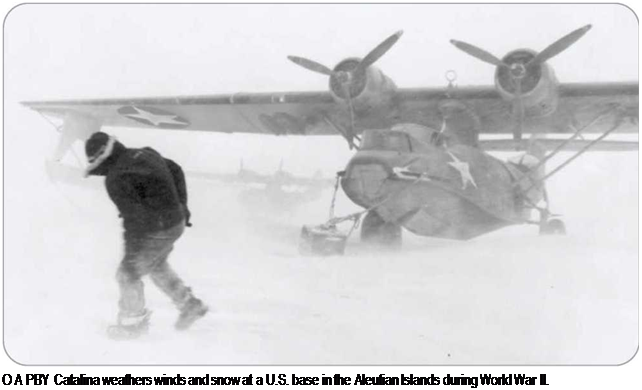Commercial Services
In the 1920s, the German firm of Dornier built the Whale, which set the pattern for later passenger flying boats. It had four engines set on top of the wing and a boat-shaped hull, with airfoil-shaped sponsons (float-like attachments to the hull) that kept the craft stable on water.
The Whale cruised at 112 miles per hour (180 kilometers per hour) for a distance of 1,243 miles (2,000 kilometers) and could carry up to nineteen passengers. Whales and the bigger Super Whales made many record-breaking flights and opened up new commercial services, such as flights from Germany to Brazil.
Pan American Airways started the first regular mail and passenger service across the Pacific Ocean in 1935, using the Martin 130 China Clipper, a flying boat. The Clipper could carry forty-eight passengers on daytime flights and eighteen passengers in a night sleeper layout. Britain also built flying boats for long- haul routes: The Short Empire flying boats (1936), for instance, flew to Africa and India.
Flying Boats at War
During World War II, navies of warring nations used flying boats and other seaplanes to attack shipping and patrol supply routes. The British built the Short Sunderland, a heavily armed patrol flying boat, to hunt Nazi submarines in the Atlantic Ocean. The Sunderland remained in service until 1959.
Probably the most famous seagoing airplane of World War II was the U. S. PBY Catalina. Built by Consolidated and first flown on March 28, 1935, the twin – engine Catalina carried a crew of up to nine people. It had a cruising speed of 117 miles per hour (188 kilometers per hour) and a range of 2,500 miles (4,023 kilometers). The Catalina offered greater range and load-carrying capacity than
 |
earlier flying boats. It flew with the British, Canadian, and Australian forces and also was built in Russia.
As well as flying patrol and bombing missions, Catalinas rescued many pilots whose airplanes had crashed into the ocean, dropping lifeboats into the water or landing to pick up fliers from the water. Most Catalinas were amphibious airplanes-they had wheels and so could land on a runway, too. Consolidated also built the larger, four-engine PB2Y Coronado, a flying boat bomber that saw service during World War II.










